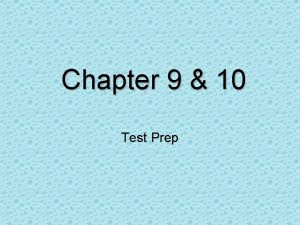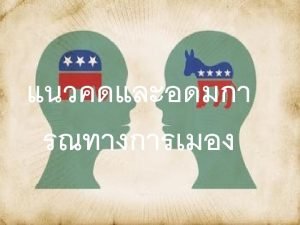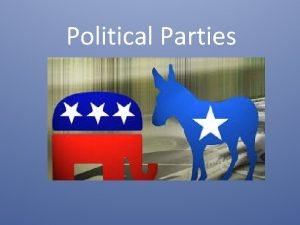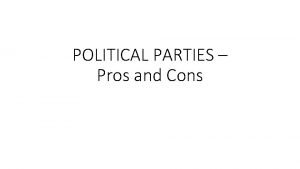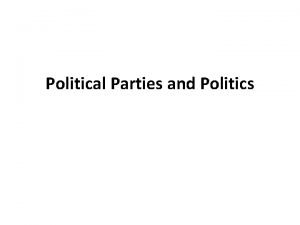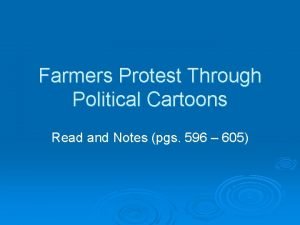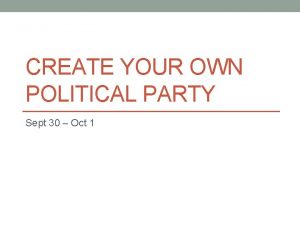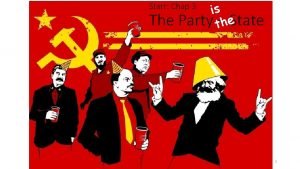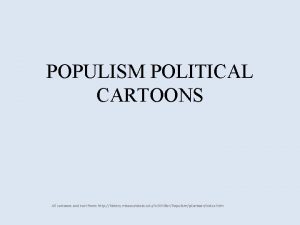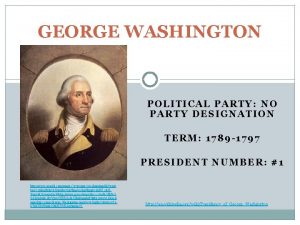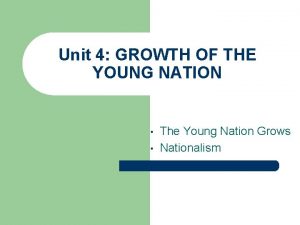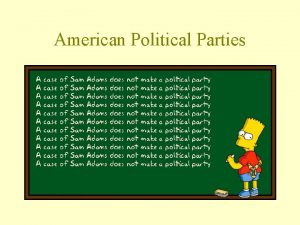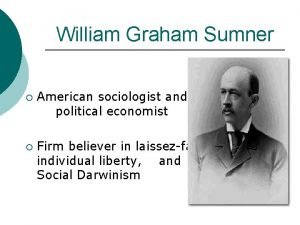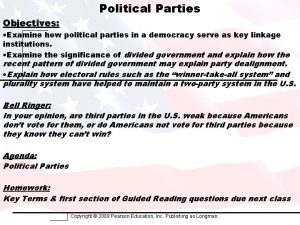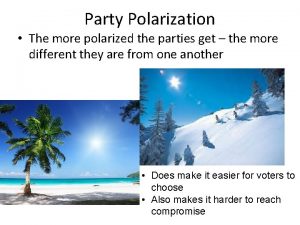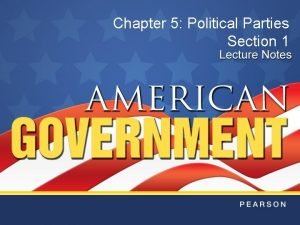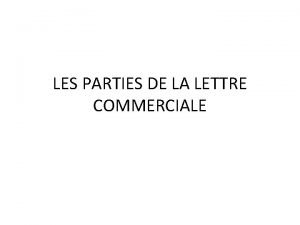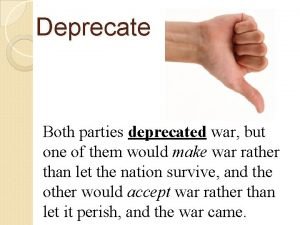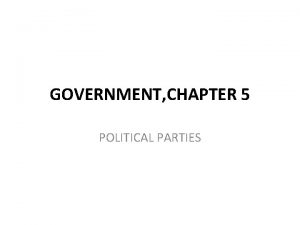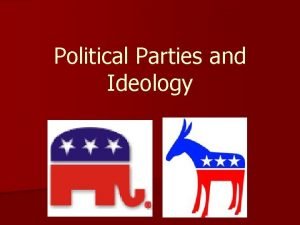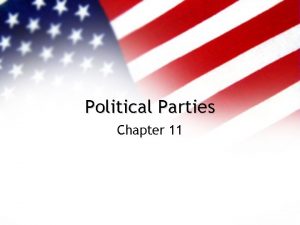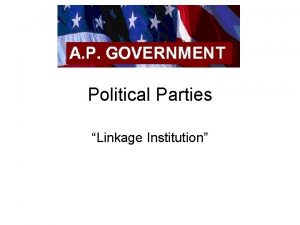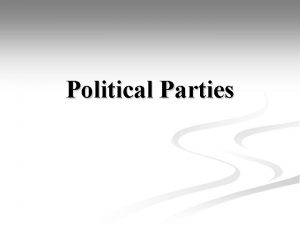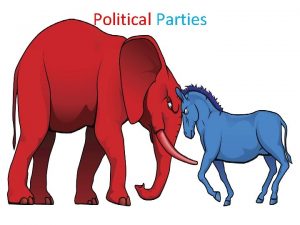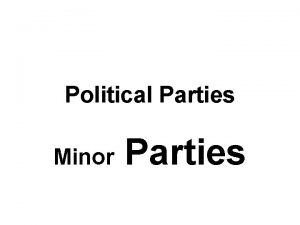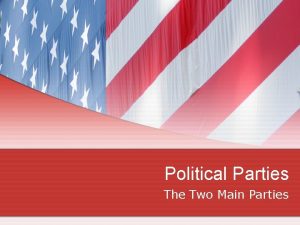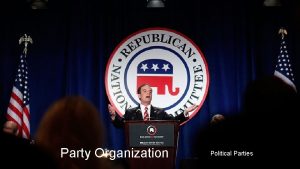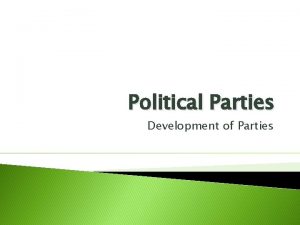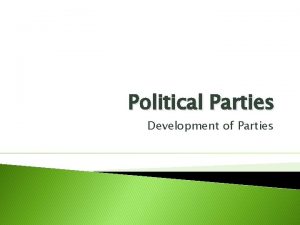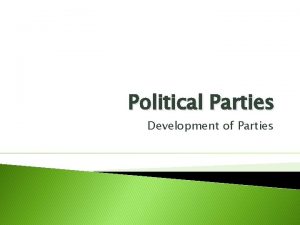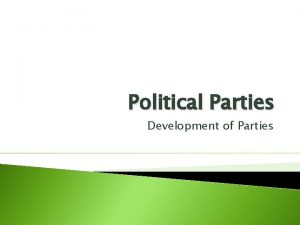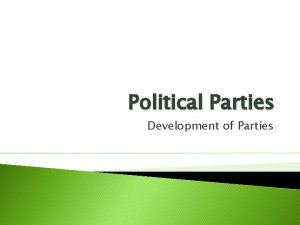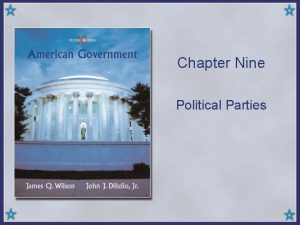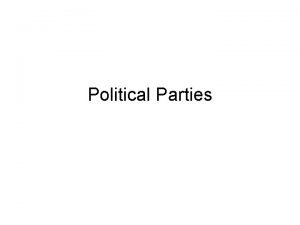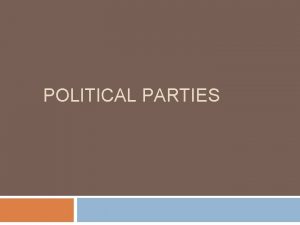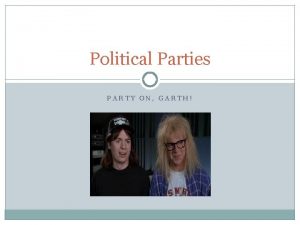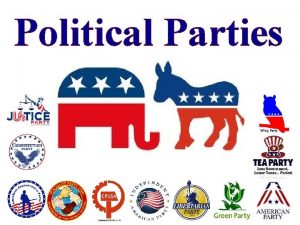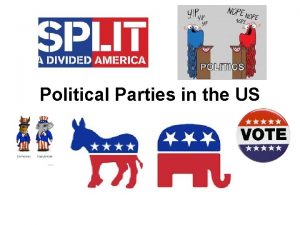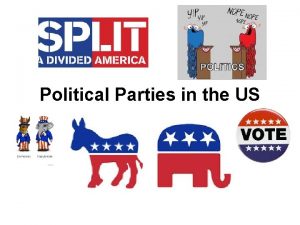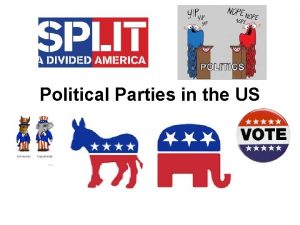Political Parties What Is a Political Party A






























- Slides: 30

Political Parties

What Is a Political Party? • A political party is a group of persons who seek to control government by winning elections and holding office. • The two major parties in American politics are the Republican and Democratic parties. • Parties can be principle-oriented, issue-oriented, or election-oriented. The American parties are electionoriented.

What Do Parties Do? l Nominate Candidates—Recruit, choose, and present candidates for public office. l Inform and Activate Supporters—Campaign, define issues, and criticize other candidates. l Act as a Bonding Agent—Guarantee that their candidate is worthy of the office. l Govern—Members of government according to their partisanship, or firm allegiance to a party. l Act as a Watchdog—Parties that are out of power keep a close eye on the actions of the party in power for a blunder to use against them in the next election.

Why a Two-Party System? l The Historical Basis. The nation started out with twoparties: the Federalists and the Anti-Federalists. l The Force of Tradition. America has a two-party system because it always had one. Minor parties, lacking wide political support, have never made a successful showing, so people are reluctant to support them. l The Electoral System. Certain features of government, such as single-member districts, are designed to favor two major parties. l Ideological Consensus. Most Americans have a general agreement on fundamental matters. Conditions that would spark several strong rival parties do not exist in the United States.

Multiparty Systems l l l Advantages Provides broader representation of the people. More responsive to the will of the people. Give voters more choices at the polls. l l Disadvantages Cause parties to form coalitions, which can dissolve easily. Failure of coalitions can cause instability in government. They are a common feature in most European democracies and in many other democratic societies in the world.

One-Party Systems Types of One-Party Systems One Party Systems where only one party is allowed. Modified One-Party Systems where one party regularly wins most elections Example: Dictatorships such as Stalinist Russia Republican North and Democratic South until the 1950 s.

Party Membership Patterns l l Each party has always been composed, in greater or lesser degree, of a cross section of the nation’s population. However, certain segments of the electorate tend to be aligned more solidly with one or the other of the major parties. In recent decades… Democrats = African Americans, Catholics and Jews, and union members Republicans = white males, Protestants and the business community

Party Membership Patterns l l l l Factors that can influence party membership: Family (most important – 2 out of 3 follow their parents) Major Events (i. e. the Civil War or Great Depression) Economic Status (higher income = Republican, lower income = Democrat) Age Place of Residence Level of Education Work Environment

The Nation’s First Parties The two-party system developed in the United States mainly because conflicts about the Constitution created opposing viewpoints. l l l Federalists Led by Alexander Hamilton Represented wealthy and upper-class interests Favored strong executive leadership and liberal interpretation of the Constitution l l l Anti-Federalists Led by Thomas Jefferson Represented the “common man” Favored Congress as the strongest arm of government and a strict interpretation of the Constitution

American Parties: Four Major Eras The Three Historical Eras The Era of the Democrats, 1800— 1860 l Democrats dominate all but two presidential elections. l The Whig Party emerges in 1834, but declines by the 1850 s, electing only two Presidents. l The Republican Party is founded in 1854.

American Parties: Four Major Eras The Three Historical Eras The Era of the Republicans, 1860— 1932 l Republicans dominate all but four presidential elections. l The Civil War disables the Democratic Party for the remainder of the 1800 s.

American Parties: Four Major Eras The Three Historical Eras The Return of the Democrats, 1932— 1968 l Democrats dominate all but two presidential elections. l Democrat Franklin D. Roosevelt is elected President four times.

American Parties: Parties Today The Start of a New Era: The Era of Divided Government Since 1968, neither Republicans nor Democrats have dominated the presidency and Congress has often been controlled by the opposing party. 1968– 1976 Republicans hold the presidency Congress is controlled by Democrats 1976– 1980 Democrats hold the presidency Congress is controlled by Democrats 1980– 1992 Republicans hold the presidency Senate controlled by Republicans 1980 -1986, controlled by Democrats from 1986 to 1994 1992 – 2000 Democrats hold the presidency Congress controlled by Republicans, 1994 to present 2000 Republicans hold the presidency Congress is controlled by Republicans

Current Era: Updated Info l 2004 l Republican President l Republican led Congress l 2008 l Democratic President l Democratic led Congress l 2012 l Democratic President l Republican led House l Democratic led Senate

Minor Parties in the United States Types of Minor Parties Ideological Parties Single-issue (based on a Parties particular set of (focus only on beliefs, many built one publicon Marxist ideas) policy matter) Example: Libertarian Party - focus on individualism and doing away with most of the government’s present functions and programs Economic Protest Parties (rooted in periods of economic discontent) Splinter Party (have split from one of the major parties) Example: “Bull Moose” Example: Progressive Party Example: Free Soil Party The Greenback Party – Theodore – opposed the – tried to take Roosevelt’s party spread of advantage of farmers that split from the slavery in the discontent from 1876 Republicans 1840 s and - 1884 1850 s

Minor Parties in the United States

Why Minor Parties Are Important l l l Minor parties play several important roles: “Spoiler Role” Minor party candidates can pull decisive votes away from one of the major parties’ candidates, especially if the minor party candidate is from a splinter party. Critic Minor parties, especially single-issue parties, often take stands on and draw attention to controversial issues that the major parties would prefer to ignore. Innovator Often, minor parties will draw attention to important issues and propose innovative solutions to problems. If these proposals gain popular support, they are often integrated into the platforms of the two major parties.

The Decentralized Nature of the Parties Both of the major parties are highly decentralized and fragmented. Why?

The Decentralized Nature of the Parties The Role of the Presidency l The President’s party is usually more solidly united and more cohesively organized than the opposing party. l l The President is automatically the party leader. The other party has no one in a comparable position

The Decentralized Nature of the Parties The Impact of Federalism l More than half a million elective offices in the United States today l Those offices are spread out among national, State, and local levels

The Decentralized Nature of the Parties The Role of the Nominating Process l The nominating process pits party members against one another because only one person can be chosen to be the party’s presidential candidate.

National Party Machinery The National Convention The National Chairperson The Congressional Campaign Committees The National Committee All four elements of both major parties work together loosely to achieve the party’s goals.

National Convention l When l Every 4 th year, the summer before a presidential election l Role l l Nominates candidates for President and Vice president Adopts party rules and platform • 2012 National Conventions • Democrats: Charlotte, North Carolina the first week of September • Republicans: Tampa, Florida the last week of August

National Committee l When l Between conventions l Role l Mainly prepares for the next national convention

National Chairperson l Term l For a four-year term l Role l Leads national committee, directions party headquarters, works to strengthen the party • Only two women have ever held the top party post: Jean Westwood (D) from 1972 -1973 and Mary Louise Smith (R) from 1974 -1977. • Only one African American has ever held the top party post: Ron Brown (D) from 1989 -1993

Congressional Campaign Committees l Term l Two years, during a term of Congress l Role l l Work to re-elect incumbents and to unseat the other party’s incumbents in each house Chosen by their colleagues

State and Local Party Machinery State and local party organization varies from State to State, but usually follow the general principles below.

The Three Components of the Party Components The Party Organization: The Party in the Electorate The Party in Government Those who run and control the party machinery. Those who always or almost always vote for party candidates. Those who hold office in the government.

The Future of Major Parties l Political parties have never been very popular in this country but most have accepted them as a necessary institution. l l Political parties have been in a period of decline since the late 1960 s. However, our two major parties have existed far longer than has any other party anywhere in the world.

The Future of Major Parties Weakened connections to political parties: For candidates: For voters : l Structural changes have l More people are unwilling increased conflict and to label themselves as disorganization within parties “Democrats” or l Changes in the technology of “Republicans” campaigning, especially the use of television and the l Split-ticket voting—voting Internet, have made for candidates of different candidates more independent parties for different offices of the party organization at the same election l The growth of single-issue organizations provides candidates with another source of financial support
 The spoils system made political parties more powerful by
The spoils system made political parties more powerful by World political parties
World political parties Political parties
Political parties Political parties
Political parties The supreme court change
The supreme court change Political parties pros and cons
Political parties pros and cons Brainpop political parties
Brainpop political parties Political
Political Fourth party logistics advantages and disadvantages
Fourth party logistics advantages and disadvantages Analyzing the populist party through political cartoons
Analyzing the populist party through political cartoons Create a political party project
Create a political party project Political party organization chart
Political party organization chart Populist political cartoon
Populist political cartoon Kathy cocuzzi political party
Kathy cocuzzi political party Edmond-charles genêt
Edmond-charles genêt Martin van buren political party
Martin van buren political party Political party
Political party Political party
Political party Graham sumner roman
Graham sumner roman Objectives of political party
Objectives of political party Political party project
Political party project What does the graph indicate?
What does the graph indicate? Why is gatsby's love for daisy doomed to fail
Why is gatsby's love for daisy doomed to fail Chapter 5 section 1 parties and what they do
Chapter 5 section 1 parties and what they do Les parties de la lettre
Les parties de la lettre Deprecated war definition
Deprecated war definition Les parties du texte
Les parties du texte Economic protest parties definition
Economic protest parties definition Self-announcement definition
Self-announcement definition Schéma installation fibre optique maison individuelle
Schéma installation fibre optique maison individuelle Accounting information system chapter 1
Accounting information system chapter 1
